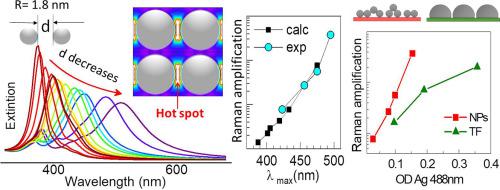当前位置:
X-MOL 学术
›
Mater. Des.
›
论文详情
Our official English website, www.x-mol.net, welcomes your
feedback! (Note: you will need to create a separate account there.)
Raman amplification in the ultra-small limit of Ag nanoparticles on SiO2 and graphene: Size and inter-particle distance effects
Materials & Design ( IF 7.6 ) Pub Date : 2020-07-01 , DOI: 10.1016/j.matdes.2020.108702 Sandra Cortijo-Campos , Rafael Ramírez-Jiménez , Esteban Climent-Pascual , Montserrat Aguilar-Pujol , Félix Jiménez-Villacorta , Lidia Martínez , Rafael Jiménez-Riobóo , Carlos Prieto , Alicia de Andrés
Materials & Design ( IF 7.6 ) Pub Date : 2020-07-01 , DOI: 10.1016/j.matdes.2020.108702 Sandra Cortijo-Campos , Rafael Ramírez-Jiménez , Esteban Climent-Pascual , Montserrat Aguilar-Pujol , Félix Jiménez-Villacorta , Lidia Martínez , Rafael Jiménez-Riobóo , Carlos Prieto , Alicia de Andrés

|
Size, shape and hot spots are crucial to optimize Raman amplification from metallic nanoparticle (NPs). The amplification from radius = 1.8 ± 0.4 nm ultra-small silver NPs was explored. Increasing NP density redshifts and widens their plasmon that, according to simulations for NPs arrays, is originated by the reduction of the interparticle distance, d, becoming remarkable for d ≤ R. Inter-particle interaction red-shifts (N130 nm) and widens (N90 nm) the standard plasmon of non-interacting spherical particles. Graphene partly delocalizes the carriers enhancing the NIR spectral weight. Raman amplification of graphene phonons is moderate and depends smoothly on d while that of Rhodamine 6G (R6G) varies almost exponentially due to their location at hotspots that depend strongly on d. The experimental correlation between amplification and plasmon position is well reproduced by simulations. The amplification originated by the ultra-small NPs is compared to that of larger particles, granular silver films with 7 < R < 15 nm grains, with similar extinction values. The amplification is found to be larger for the 1.8nm NPs due to the higher surface/volume ration that allows higher density of hot spots. It is demonstrated that Raman amplification can be efficiently increased by depositing low density layers of ultra-small NPs on top of granular films.
中文翻译:

Ag 纳米粒子在 SiO2 和石墨烯上的超小极限中的拉曼放大:尺寸和粒子间距离效应
尺寸、形状和热点对于优化金属纳米颗粒 (NP) 的拉曼放大至关重要。探索了半径 = 1.8 ± 0.4 nm 超小银纳米颗粒的放大率。根据对 NPs 阵列的模拟,增加 NP 密度红移并加宽其等离子体激元,这源于粒子间距离 d 的减少,当 d ≤ R 时变得显着。粒子间相互作用红移(N130 nm)并加宽( N90 nm) 非相互作用球形粒子的标准等离子体。石墨烯部分地使载流子离域,增强了 NIR 光谱权重。石墨烯声子的拉曼放大适中并且平稳地依赖于 d 而罗丹明 6G (R6G) 的拉曼放大几乎呈指数变化,因为它们位于强烈依赖于 d 的热点。放大和等离子体位置之间的实验相关性通过模拟很好地再现。由超小 NPs 产生的放大与较大颗粒的放大相比,颗粒银膜具有 7 < R < 15 nm 颗粒,具有相似的消光值。发现 1.8nm NP 的放大更大,因为更高的表面积/体积比允许更高的热点密度。结果表明,通过在颗粒薄膜上沉积低密度的超小纳米颗粒层,可以有效地提高拉曼放大率。8nm NPs 由于更高的表面积/体积比,允许更高的热点密度。结果表明,通过在颗粒薄膜上沉积低密度的超小纳米颗粒层,可以有效地提高拉曼放大率。8nm NPs 由于更高的表面积/体积比允许更高的热点密度。结果表明,通过在颗粒薄膜上沉积低密度的超小纳米颗粒层,可以有效地提高拉曼放大率。
更新日期:2020-07-01
中文翻译:

Ag 纳米粒子在 SiO2 和石墨烯上的超小极限中的拉曼放大:尺寸和粒子间距离效应
尺寸、形状和热点对于优化金属纳米颗粒 (NP) 的拉曼放大至关重要。探索了半径 = 1.8 ± 0.4 nm 超小银纳米颗粒的放大率。根据对 NPs 阵列的模拟,增加 NP 密度红移并加宽其等离子体激元,这源于粒子间距离 d 的减少,当 d ≤ R 时变得显着。粒子间相互作用红移(N130 nm)并加宽( N90 nm) 非相互作用球形粒子的标准等离子体。石墨烯部分地使载流子离域,增强了 NIR 光谱权重。石墨烯声子的拉曼放大适中并且平稳地依赖于 d 而罗丹明 6G (R6G) 的拉曼放大几乎呈指数变化,因为它们位于强烈依赖于 d 的热点。放大和等离子体位置之间的实验相关性通过模拟很好地再现。由超小 NPs 产生的放大与较大颗粒的放大相比,颗粒银膜具有 7 < R < 15 nm 颗粒,具有相似的消光值。发现 1.8nm NP 的放大更大,因为更高的表面积/体积比允许更高的热点密度。结果表明,通过在颗粒薄膜上沉积低密度的超小纳米颗粒层,可以有效地提高拉曼放大率。8nm NPs 由于更高的表面积/体积比,允许更高的热点密度。结果表明,通过在颗粒薄膜上沉积低密度的超小纳米颗粒层,可以有效地提高拉曼放大率。8nm NPs 由于更高的表面积/体积比允许更高的热点密度。结果表明,通过在颗粒薄膜上沉积低密度的超小纳米颗粒层,可以有效地提高拉曼放大率。











































 京公网安备 11010802027423号
京公网安备 11010802027423号